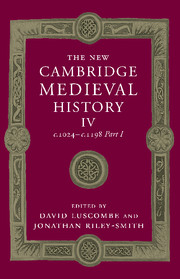Book contents
- Frontmatter
- 1 Introduction
- 2 The Rural Economy and Demographic Growth
- 3 Towns and the Growth of Trade
- 4 Government and Community
- 5 The Development of Law
- 6 Knightly Society
- 7 War, Peace and the Christian Order
- 8 The Structure of the Church, 1024–1073
- 9 Reform and the Church, 1073–1122
- 10 Religious Communities, 1024–1215
- 11 The Institutions of the Church, 1073–1216
- 12 Thought and Learning
- 13 Religion and the Laity
- 14 The Crusades, 1095–1198
- 15 The Eastern Churches
- 16 Muslim Spain and Portugal: Al-Andalus and its Neighbours
- 17 The Jews in Europe and the Mediterranean Basin
- 18 Latin and Vernacular Literature
- 19 Architecture and the Visual Arts
- List of Primary Sources
- Bibliography of secondary works arranged by chapter
- Index
- Frontispiece">
- Plate section"
- References
16 - Muslim Spain and Portugal: Al-Andalus and its Neighbours
Published online by Cambridge University Press: 28 March 2008
- Frontmatter
- 1 Introduction
- 2 The Rural Economy and Demographic Growth
- 3 Towns and the Growth of Trade
- 4 Government and Community
- 5 The Development of Law
- 6 Knightly Society
- 7 War, Peace and the Christian Order
- 8 The Structure of the Church, 1024–1073
- 9 Reform and the Church, 1073–1122
- 10 Religious Communities, 1024–1215
- 11 The Institutions of the Church, 1073–1216
- 12 Thought and Learning
- 13 Religion and the Laity
- 14 The Crusades, 1095–1198
- 15 The Eastern Churches
- 16 Muslim Spain and Portugal: Al-Andalus and its Neighbours
- 17 The Jews in Europe and the Mediterranean Basin
- 18 Latin and Vernacular Literature
- 19 Architecture and the Visual Arts
- List of Primary Sources
- Bibliography of secondary works arranged by chapter
- Index
- Frontispiece">
- Plate section"
- References
Summary
the taifa kingdoms, c. 1010–c. 1086
In the year 1000 the caliphate of Córdoba was almost certainly the richest and most powerful polity in western Europe. A prosperous agriculture and a developed cash economy were taxed to support a standing, professional army and an extensive literate bureaucracy. The country was effectively united under the authority of the Umayyad dynasty of Córdoba, the permanent capital and seat of government. Under the rule of the two caliphs, ‘Abd al-Rahman al-Nasir (912–61) and al-Hakam al-Mustansir (961–76) the state had been immensely strengthened. Their legacy was inherited by Muhammad b. Abi Amir al-Mansur (976–1002) who effectively ruled as military protector to the reclusive Caliph Hisham, a period in which the power of Córdoba reached its apogee. Only in Constantinople could a comparable state be found. Unlike those of the Byzantine empire, however, the frontiers of al-Andalus were free from major outside threats: to the north the Christian kingdoms and counties had b en repeatedly raided and their armed forces worsted in battle, culminating in the humiliating sack of Santiago de Compostela in 999. To the south, the Berbers of the Maghreb were divided into the clients of Córdoba and their enemies, but none offered a serious challenge. The removal of the Fatimids from Tunisia to Egypt in 969 meant that there was no threat to al-Andalus from the Muslim east.
- Type
- Chapter
- Information
- The New Cambridge Medieval History , pp. 599 - 622Publisher: Cambridge University PressPrint publication year: 2004
References
- 1
- Cited by

